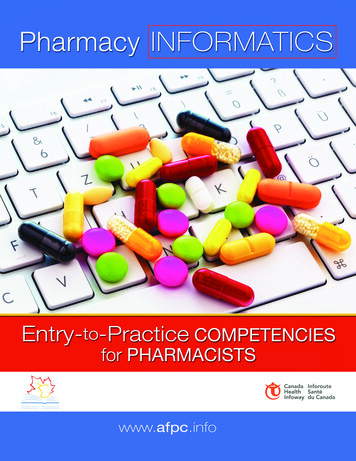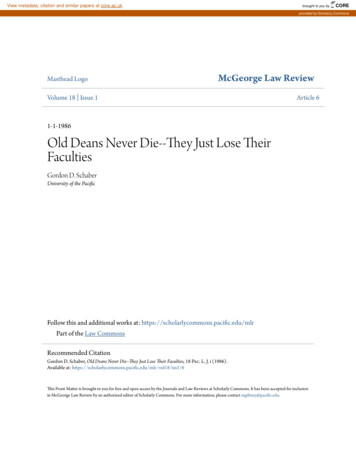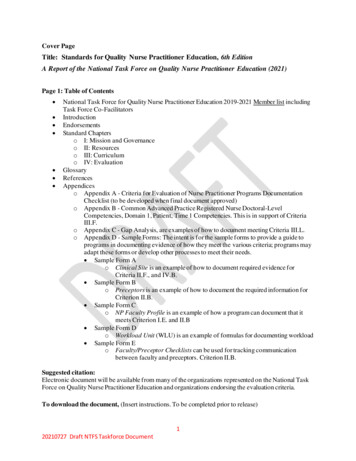
Transcription
ACKNOWLEDGEMENTSThe Association of Faculties of Pharmacy of Canada (AFPC) gratefully acknowledges the expertise, time andcontributions of all those involved in the development and validation of these national competencies andindicators related to Information and Communication Technology (ICT). Production of this document wassupported by the Canada Health Infoway - AFPC Clinicians in Training program.CORE PROJECT TEAMMarie Rocchi, Faculty Lead . . . . . . . . . University of TorontoHarold Lopatka, Project Sponsor . . . . . Association of Faculties of Pharmacy of CanadaNancy Kleiman . . . . . . . . . . . . . . . . . . University of ManitobaLisa Bishop . . . . . . . . . . . . . . . . . . . . . Memorial University of NewfoundlandNeil de Haan . . . . . . . . . . . . . . . . . . . . BC Cancer AgencyDonna Pipa . . . . . . . . . . . . . . . . . . . . . Project ManagerPROJECT STEERING COMMITTEEDave Edwards . . . . . . . . . . . . . . . . . . . AFPC Council of Deans, University of WaterlooNancy Waite . . . . . . . . . . . . . . . . . . . . AFPC Council of Faculties, University of WaterlooMarc Desgagne . . . . . . . . . . . . . . . . . . AFPC Council of Faculties, Université LavalJustin Bates . . . . . . . . . . . . . . . . . . . . CACDSJillian Grocholsky . . . . . . . . . . . . . . . . CAPSIJanet MacDonnell . . . . . . . . . . . . . . . . CPhAMargaret Woodruff . . . . . . . . . . . . . . . . CPTEADoris Nessim . . . . . . . . . . . . . . . . . . . . CSHPAnne Fazzalari . . . . . . . . . . . . . . . . . . . Canada Health InfowayValerie Leung . . . . . . . . . . . . . . . . . . . . Canada Health Infoway11PHARMACY INFORMATICS ENTRY-TO-PRACTICE COMPETENCIES FOR PHARMACISTS
INTRODUCTIONPharmacy practice continues to change from a drug distribution focus to expanded scopes of practice witha major emphasis on improving patient care and health outcomes. Information and information technologyneeds are also evolving to enable and support this change. Optimized use of health and pharmacy information,as well as information technology is a critical success factor for this shift. While Canadian pharmacy facultiescurrently provide education on information and information technology, few have dedicated courses andmaterials about this important topic.The Association of Faculties of Pharmacy of Canada (AFPC) and Canada Health Infoway (Infoway) havepartnered together to develop a national on-line, competency based, educational program to help prepareundergraduate pharmacy students in optimizing the use of Information and Communication Technologies (ICT).The first phase of the project was to develop and validate a competency framework related to use of ICT bygraduates of first pharmacy professional degree programs. The following competencies and competencyDISEMRe-prescribeCDS CPOEpharmacy management systemsocial mediae-healthEHRiPadpersonal health portale-prescribeindicators are a result of input from key pharmacy stakeholders.EMRsmartphonePHARMACY INFORMATICS EMRCDSCPOEsocial mediae-healthiPadpharmacy management systemEHRDISpersonal health portale-prescribeCDS CPOEpharmacy management systemsocial mediae-healthEHRiPadpersonal health portalDISsmartphonesmartphoneENTRY-TO-PRACTICE COMPETENCIES FOR PHARMACISTS2
METHODSAn initial draft set of entry to practice competencies for pharmacy students enrolled in firstprofessional degree programs in Canada was developed through the following process:1. Literature review for competency statements and frameworks2. Review of existing, validated, relevant competency frameworks including: Canadian Association of Schools of Nursing (CASN, 2012) Association of Faculties of Pharmacy of Canada (AFPC, 2010) COACH (Canada’s Health Informatics Association, 2009) Building Core Competencies in Pharmacy Informatics (Fox, Thrower, Felkey2010, American Pharmacists Association) American Medical Informatics Association (AMIA, 2012)3. Compilation of a hybrid set of competencies and competency indicators felt to berelevant to the project4. Consideration of pharmacy-specific context and modification of competencieswhere appropriateA survey was created to determine the relevance and priority of each indicator. A link to thesurvey was distributed to the following key pharmacy stakeholders with the expectation thatthe survey would be forwarded to their respective constituents by a branching technique: Project Steering CommitteeAFPC CouncilorsNAPRAPEBCCPhAInfoway Pharmacist Reference GroupPEP Canada CommitteeCSHPCSHP Pharmacy Informatics Specialty NetworkSurvey participants were asked to:1. Determine the content validity of each competency (and accompanying indicator)statement and,2. Prioritize the competencies (and indicators) to drive the next phase of programdesign and development.3PHARMACY INFORMATICS ENTRY-TO-PRACTICE COMPETENCIES FOR PHARMACISTS
FOUNDATIONAL SKILLSIt is expected that students will possess these foundational skills prior to entering anundergraduate pharmacy program.DEVICE USEF1.F2.Demonstrates basic skills with ICT components(e.g. features of personal computers, hand helddevices, tablets, workstations, modems,Bluetooth-enabled devices, keyboarding, use ofperipheral devices including printers, USB flashdrives, CD-ROMs, uploading and downloadingdata, smart phones, mouse and touch-padinterchangeably, etc.)Uses intranet and extranet networks to navigatesystems (e.g., access to shared file servers, virtual private networks, World Wide Web, cloudcomputing, browsers)APPLICATION USEF3.Uses electronic communication (e.g.email to create, send, respond, attachand receive attachments)PHARMACY INFORMATICS F4.Is familiar with multimedia presentations (e.g.videos, podcasts, blogs, YouTube, etc.)F5.Uses word processing, spreadsheets andpresentation graphics (e.g. document,spreadsheet, slideshow creation, etc.)F6.Navigates primary operating systems(e.g. Windows and Apple to manage files,determine active printers, access installedapplications, create and delete files, etc.)F7.Uses technology for self-directed learning(e.g. learning management systems)F8.Is familiar with social networkingapplications (e.g. Twitter, Facebook,LinkedIn, etc.)ENTRY-TO-PRACTICE COMPETENCIES FOR PHARMACISTS4
INTRODUCTION toCOMPETENCIES & INDICATORSThe following informatics competencies are expected to have been acquired by pharmacystudents over the course of their undergraduate education.These pharmacy informatics competencies and indicators were prepared to guide developmentof the AFPC - Infoway national on-line educational program to help prepare undergraduatepharmacy students in optimizing the use of Information and Communication Technologies (ICT).A competency is a complex “know-act” based on combining and mobilizing inter nalresources (knowledge, skills, and attitudes) and external resources to apply appropriatelyto specific types of situations. (Tardiff, 2006). Indicators are assessable and observablemanifestations of the critical learnings needed to develop the competency.5PHARMACY INFORMATICS ENTRY-TO-PRACTICE COMPETENCIES FOR PHARMACISTS
COMPETENCIES & INDICATORSCOMPETENCY #1: INFORMATION AND KNOWLEDGE MANAGEMENTUses relevant information and knowledge to support the delivery of evidence-based patient care1.1Performs search, retrieval, and critical appraisal from a variety of sources (includingscholarly articles, websites, clinical applications, practice guidelines, and experts)to support clinical judgement1.2Uses audience-appropriate communication and language to present information andconvey concepts1.3Assesses the key attributes of data and information (e.g. quality, accuracy, integrity,timeliness, appropriateness), their limitations within the context of intended use (e.g.clinical and analytical uses), and their impact on knowledge creation and use1.4Facilitates appropriate consumer use of health information and related technologiesby assisting patients and their families to access, review and evaluate informationthey retrieve for currency, credibility and relevance, and with leveraging ICTs tomanage their health (e.g. Personal Health Records, social media sites, smart phoneapplications, online support groups, etc.)1.5Promotes an information culture by encouraging and facilitating appropriate usesof information and knowledge1.6Recognizes commonly used formats (e.g. SOAP notes), templates, structures (e.g.patient charts) and methods (e.g. digital, manual) for recording and communicatingclinical data and how these are incorporated into system and application use1.7Understands data interrelationships and dependencies among the various healthinformation systems (e.g. decision support systems, electronic health records,computerized provider order entry, etc.)1.8Recognizes need for interoperable health records (medications, diagnoses, careplans) across the healthcare system and uses information standards (i.e. messagingstandards and standardized clinical terminologies) to enable this goalCOMPETENCIES & INDICATORS.CONTINUED on PAGE 7PHARMACY INFORMATICS ENTRY-TO-PRACTICE COMPETENCIES FOR PHARMACISTS6
COMPETENCIES & INDICATORS.CONTINUED from PAGE 61.9Utilizes ICTs (e.g. email, social media) appropriately in communicating with patientsin compliance with legal, privacy, and regulatory requirements1.10Describes the processes of data gathering, recording and retrieval, in hybrid orhomogenous health records (electronic or paper format) and identifies benefits,risks, gaps, and inconsistencies across the healthcare system1.11Analyses, interprets, and documents pertinent health, pharmacy, and patient datausing standardized clinical terminologies to support clinical decision making andcollaborative patient-centred care1.12Understands need for interoperability of health records and data exchange and itsimpact on collaborative patient-centred care1.13Demonstrates understanding of health information terminology (e.g. classifications,vocabularies, nomenclature, abbreviations, acronyms, etc.) and standards, and theirappropriate useCOMPETENCY #2: PROFESSIONAL AND REGULATORY ACCOUNTABILITYUses ICTs in accordance with professional and regulatory standards and workplace policies2.1Complies with legal and regulatory requirements, ethical standards, and organizationalpolicies and procedures (includes protection of health information and maintainingprivacy, and ensuring security e.g. collection, use, disclosure, access to, protection,and destruction of health information)2.2Demonstrates an understanding of: (i) Current legislation; (ii) Professional, ethical,and legal obligations; (iii) Guidelines relating to privacy, confidentiality, and securityof health information2.3Maintains effective pharmacy practice and patient safety during any period ofsystem unavailability2.4Recognizes the importance of commitment by health care professionals, vendors,organizations, governments, business enterprises (pharmacies), and institutionsin the optimization of applications and systems in health care as a platform forintegrated, collaborative, patient-centred care7PHARMACY INFORMATICS ENTRY-TO-PRACTICE COMPETENCIES FOR PHARMACISTS
2.5Reports system process and functional issues (e.g. error messages, misdirections,device malfunctions, etc.) according to organizational policies and procedures2.6Participates in assessment of health technologies and understands decision makingand analytical frameworks for the use of current information and communicationtechnologies that support the delivery of safe, quality careCOMPETENCY #3: INFORMATION AND COMMUNICATION TECHNOLOGIESUses information and communication technologies in the delivery of patient/client care3.1Demonstrates efficient and responsible use of clinical decision support tools(e.g. clinical alerts and reminders, critical pathways, clinical practice guidelines,etc.) to assist clinical judgement and safe patient care3.2Documents patient care activities in a timely, retrievable, usable manner for accessby other care providers, and in the interest of patient care outcomes and safety3.3Uses ICTs in a manner that supports (i.e. does not interfere with) the pharmacistpatient relationship and those with colleagues; undertakes face-to-face communicationstrategies when warranted3.4Demonstrates use of a variety of information and communication technologies (e.g.Pharmacy Information Systems, telepharmacy, EHR, EMR, point of care systems)to deliver collaborative patient-centred care to diverse populations in a varietyof settings3.5Actively makes their expertise available to others and willingly agrees to sharerelevant information, using language that is context appropriate3.6Identifies the various components of electronic records used across thecontinuum of care (e.g. EHR, EMR, PHR, etc.) and their clinical, administrative andresearch uses3.7Evaluates the factors critical to safe and efficient medication distribution systemsincluding pharmacy layout / design, workflow, technology and automationCOMPETENCIES & INDICATORS.CONTINUED on PAGE 9PHARMACY INFORMATICS ENTRY-TO-PRACTICE COMPETENCIES FOR PHARMACISTS8
COMPETENCIES & INDICATORS.CONTINUED from PAGE 83.8Commits to the benefits of informaticsto improve patient outcomes, healthcare quality benchmarks, and thequality of interprofessional patient care3.9Describes the structure and keyelements of computerized providerorder entry and electronic prescribingprocesses3.10Explains technologies and systemsused to automate the medicationdelivery process and impact onpatient safety3.11Understands key information technologyconcepts, principles and components(e.g. networks, storage devices,operating systems, information retrieval,data warehousing, application, firewalls,etc.) and their interrelationships3.12Distinguishes between telehealth,telemedicine and telepharmacy,provides examples of each, anddiscusses benefits and issuesinherent in these health deliverymodels9PHARMACY INFORMATICS ENTRY-TO-PRACTICE COMPETENCIES FOR PHARMACISTS
GLOSSARYCOMPETENCY— a complex “know-act” based on combining and mobilizing internalresources (knowledge, skills, and attitudes) and external resources toapply appropriately to specific types of situations.DECISION SUPPORT TOOLS— tools used for enhancing health-related decisions and actions withpertinent, organized clinical knowledge and patient information toimprove health and healthcare deliveryELECTRONIC HEALTH RECORD (EHR)— a record of an individual’s key health history and care, availableelectronically to authorized health care providers in support of highquality patient care.ELECTRONIC MEDICAL RECORD (EMR)— an electronic patient record specific to a clinician’s (e.g. physician)practice or organization.INDICATOR— assessable and observable manifestation of the critical learningsneeded to develop a competencyINFORMATION AND COMMUNICATIONTECHNOLOGY (ICT)— encompasses all digital and analog technologies that facilitatethe capturing, processing, storage and exchange of information viaelectronic communication.PHARMACY INFORMATICS— use and integration of data, information, knowledge, technology andautomation for the purpose of improving health outcomesPERSONAL HEALTH RECORD (PHR)— a complete or partial health record under the custodianship of aperson(s) (e.g. a patient or family member) that holds all or a portionof the relevant health information about that person over a lifetime.REFERENCES:Entry to Practice Competencies for Nurses (CASN-Infoway, 2012)Educational Outcomes Extracted from: First Professional Degree Programs in Pharmacy (AFPC, June 2010)SELECTED Health Information Professional Core Competencies (Version 2.0, March 2009) COACHInformatics Competency Statements (Building Core Competencies in Pharmacy Informatics) (Fox, Thrower & Felkey, 2010)American Medical Informatics Association (AMIA), 2012PHARMACY INFORMATICS ENTRY-TO-PRACTICE COMPETENCIES FOR PHARMACISTS10
AFPCCopyright 2013
using standardized clinical terminologies to support clinical decision making and collaborative patient-centred care 1.12 Understands need for interoperability of health records and data exchange and its impact on collaborative patient-centred care 1.13 Demonstrates understanding of health information terminology (e.g. classifications,











